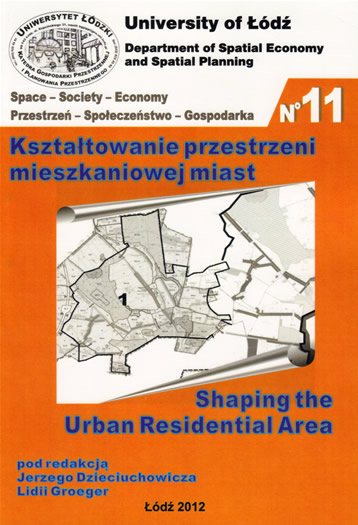NOWE BUDOWNICTWO WIELORODZINNE W STREFIE WIELKICH OSIEDLI MIESZKANIOWYCH NA PRZYKŁADZIE NOWEJ HUTY
DOI:
https://doi.org/10.18778/1733-3180.11.12Abstrakt
This study examines new, multi-family residential development in Nowa Huta with a special regard to the contemporary changes which have altered the space of socialistic, large-panel system housing complexes after 1989. The authors conducted a field research mapping all residential edifices erected after 1995, also recording their sizes, number of stores and apartments. In addition, an array of other information was subsequently collected according to whether they were present inside or in the vicinity of new buildings: gas connection, playground, elevator, underground parking lot, security, steel fences and human services. The majority of new residential development emerges at the edge or within the vacant land remained in the ‘old’ housing complexes. However, the sizes of this new development are not as impressive as they were frequently attained during the vibrant socialistic investments. Many new buildings lack rudimentary elements such as gas connections or playgrounds. Surprisingly, some of the buildings constructed shortly after 1995 need constant repairs presently. This is the result of a lesser interest in technical quality in favor of their quantity. Most of such investments were carried out by private developers who dominated the housing market in the late 1990s. Various forms of security and underground parking lots have become the standard components of the newly-constructed buildings. Likewise, an increase in the number of services has also been observed though the traditional food and garment stores usually present in the older buildings are now being replaced by more advanced services offered by medical, financial or computer enterprises.
Pobrania
Bibliografia
Basista A., 2001, Betonowe dziedzictwo, PWN, Warszawa-Kraków.
Google Scholar
Chmielewski J. M., Mirecka M., 2001, Modernizacja osiedli mieszkaniowych, Oficyna Wydawnicza Politechniki Warszawskiej, Warszawa.
Google Scholar
Czepczyński M. (red), 2006, Przestrzenie miast post-socjalistycznych. Studia społecznych przemian przestrzeni zurbanizowanej, Katedra Geografii Ekonomicznej Uniwersytetu Gdańskiego, Wyd. Bogucki, Gdańsk-Poznań.
Google Scholar
Encyklopedia Krakowa, 2000, Wydawnictwo Naukowe PWN, Kraków–Warszawa.
Google Scholar
Gąsior-Niemiec A., Glasze G., Putz R., Sinz D., 2007, Grodzenie miasta: casus Warszawy, „Studia Regionalne i Lokalne”, nr 4 (30).
Google Scholar
Gorczyca K., 2009, Wielkie osiedla mieszkaniowe – diagnoza stanu obecnego, działania rewitalizacyjne [w:] Jarczewski W. (red.), Przestrzenne aspekty rewitalizacji, śródmieścia, blokowiska, tereny poprzemysłowe, pokolejowe i powojskowe, IRM, Kraków.
Google Scholar
Jałowiecki B., 2007, Fragmentaryzacja i prywatyzacja przestrzeni [w:] Jałowiecki B., Łukowski W. (red.), Gettoizacja polskiej przestrzeni miejskiej, Wyd. Wyższej Szkoły Psychologii Społecznej, „Academica”, Wyd. Naukowe Scholar.
Google Scholar
Jędrzejuk H., 2006, Optymalizacja osiedli mieszkaniowych, Polska Akademia Nauk, Komitet Inżynierii Lądowej i Wodnej, Instytut Podstawowych Problemów Techniki, Warszawa.
Google Scholar
Luchter B., 2000, Tereny zabudowy mieszkaniowej wielorodzinnej w Krakowie w latach 1983-1998, Zeszyty Naukowe Akademii Ekonomicznej w Krakowie, nr 545.
Google Scholar
Węcławowicz G., 2007, Geografia społeczna miast, PWN, Warszawa.
Google Scholar
Zborowski A., 2005, Przemiany struktury społeczno-przestrzennej regionu miejskiego w okresie realnego socjalizmu i transformacji ustrojowej (na przykładzie Krakowa), IGiGP, Kraków.
Google Scholar
Pobrania
Opublikowane
Jak cytować
Numer
Dział
Licencja

Praca jest udostępniana na licencji Creative Commons Attribution-NonCommercial-NoDerivatives 3.0 Unported License.









